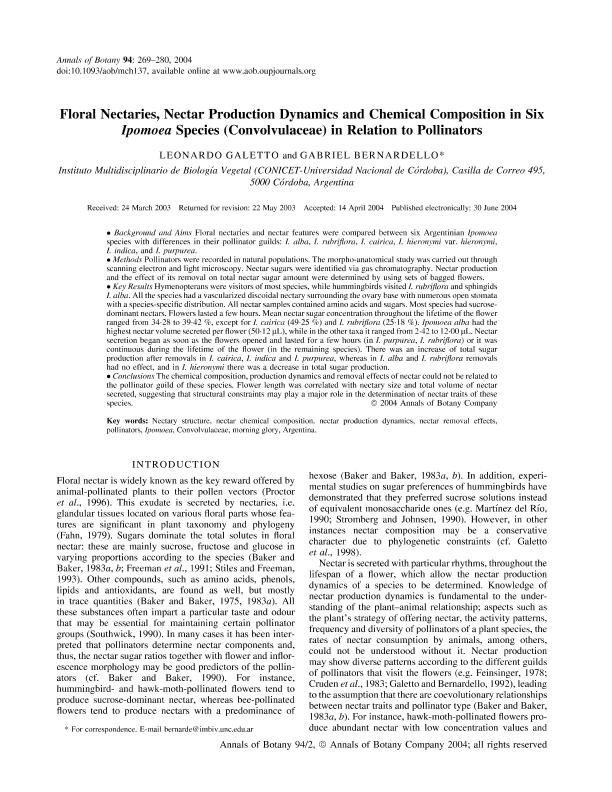Mostrar el registro sencillo del ítem
dc.contributor.author
Galetto, Leonardo

dc.contributor.author
Bernardello, Gabriel Luis Mario

dc.date.available
2018-04-04T12:13:31Z
dc.date.issued
2004-08
dc.identifier.citation
Galetto, Leonardo; Bernardello, Gabriel Luis Mario; Floral nectaries, nectar production dynamics, and chemical composition in six Ipomoea species (Convulvulaceae) in relation to pollinators; Oxford University Press; Annals of Botany; 94; 2; 8-2004; 269-280
dc.identifier.issn
0305-7364
dc.identifier.uri
http://hdl.handle.net/11336/40642
dc.description.abstract
Background and Aims Floral nectaries and nectar features were compared between six Argentinian Ipomoea species with differences in their pollinator guilds: I. alba, I. rubriflora, I. cairica, I. hieronymi var. hieronymi, I. indica, and I. purpurea.
• Methods Pollinators were recorded in natural populations. The morpho-anatomical study was carried out through scanning electron and light microscopy. Nectar sugars were identified via gas chromatography. Nectar production and the effect of its removal on total nectar sugar amount were determined by using sets of bagged flowers.
• Key Results Hymenopterans were visitors of most species, while hummingbirds visited I. rubriflora and sphingids I. alba. All the species had a vascularized discoidal nectary surrounding the ovary base with numerous open stomata with a species-specific distribution. All nectar samples contained amino acids and sugars. Most species had sucrose-dominant nectars. Flowers lasted a few hours. Mean nectar sugar concentration throughout the lifetime of the flower ranged from 34·28 to 39·42 %, except for I. cairica (49·25 %) and I. rubriflora (25·18 %). Ipomoea alba had the highest nectar volume secreted per flower (50·12 µL), while in the other taxa it ranged from 2·42 to 12·00 µL. Nectar secretion began as soon as the flowers opened and lasted for a few hours (in I. purpurea, I. rubriflora) or it was continuous during the lifetime of the flower (in the remaining species). There was an increase of total sugar production after removals in I. cairica, I. indica and I. purpurea, whereas in I. alba and I. rubriflora removals had no effect, and in I. hieronymi there was a decrease in total sugar production.
• Conclusions The chemical composition, production dynamics and removal effects of nectar could not be related to the pollinator guild of these species. Flower length was correlated with nectary size and total volume of nectar secreted, suggesting that structural constraints may play a major role in the determination of nectar traits of these species.
dc.format
application/pdf
dc.language.iso
eng
dc.publisher
Oxford University Press

dc.rights
info:eu-repo/semantics/openAccess
dc.rights.uri
https://creativecommons.org/licenses/by-nc-sa/2.5/ar/
dc.subject
Nectary Structure
dc.subject
Nectar Chemical
dc.subject
Ipomoea
dc.subject
Convolvulaceae
dc.subject.classification
Otras Ciencias Biológicas

dc.subject.classification
Ciencias Biológicas

dc.subject.classification
CIENCIAS NATURALES Y EXACTAS

dc.title
Floral nectaries, nectar production dynamics, and chemical composition in six Ipomoea species (Convulvulaceae) in relation to pollinators
dc.type
info:eu-repo/semantics/article
dc.type
info:ar-repo/semantics/artículo
dc.type
info:eu-repo/semantics/publishedVersion
dc.date.updated
2018-04-03T19:18:52Z
dc.identifier.eissn
1095-8290
dc.journal.volume
94
dc.journal.number
2
dc.journal.pagination
269-280
dc.journal.pais
Reino Unido

dc.journal.ciudad
Oxford
dc.description.fil
Fil: Galetto, Leonardo. Consejo Nacional de Investigaciones Científicas y Técnicas. Centro Científico Tecnológico Conicet - Córdoba. Instituto Multidisciplinario de Biología Vegetal. Universidad Nacional de Córdoba. Facultad de Ciencias Exactas Físicas y Naturales. Instituto Multidisciplinario de Biología Vegetal; Argentina
dc.description.fil
Fil: Bernardello, Gabriel Luis Mario. Consejo Nacional de Investigaciones Científicas y Técnicas. Centro Científico Tecnológico Conicet - Córdoba. Instituto Multidisciplinario de Biología Vegetal. Universidad Nacional de Córdoba. Facultad de Ciencias Exactas Físicas y Naturales. Instituto Multidisciplinario de Biología Vegetal; Argentina
dc.journal.title
Annals of Botany

dc.relation.alternativeid
info:eu-repo/semantics/altIdentifier/url/https://www.ncbi.nlm.nih.gov/pmc/articles/PMC4242162/
dc.relation.alternativeid
info:eu-repo/semantics/altIdentifier/doi/https://dx.doi.org/10.1093%2Faob%2Fmch137
Archivos asociados
